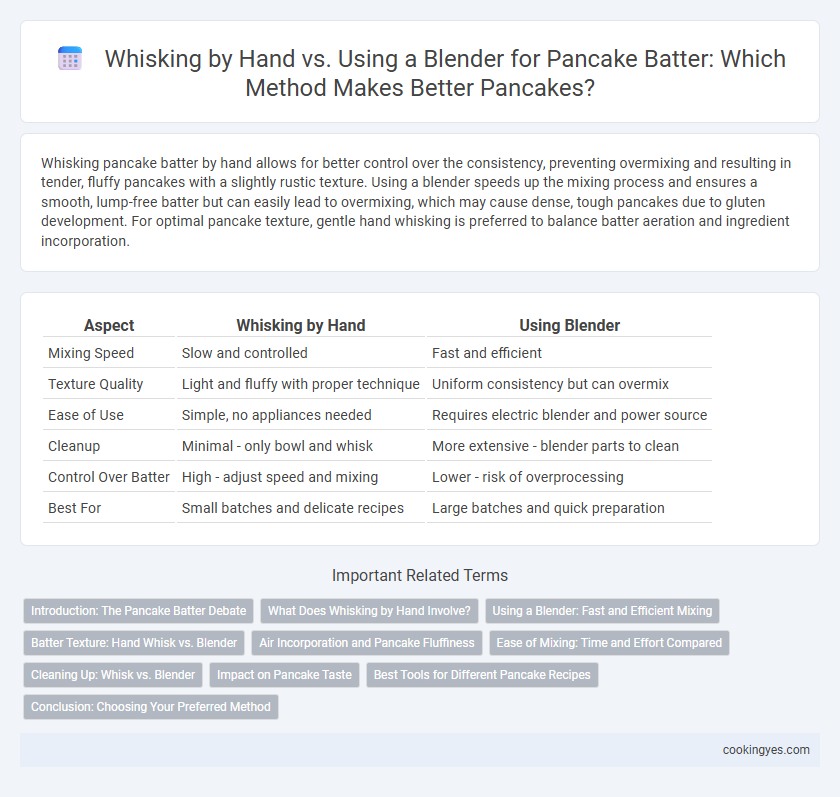Whisking pancake batter by hand allows for better control over the consistency, preventing overmixing and resulting in tender, fluffy pancakes with a slightly rustic texture. Using a blender speeds up the mixing process and ensures a smooth, lump-free batter but can easily lead to overmixing, which may cause dense, tough pancakes due to gluten development. For optimal pancake texture, gentle hand whisking is preferred to balance batter aeration and ingredient incorporation.
Table of Comparison
| Aspect | Whisking by Hand | Using Blender |
|---|---|---|
| Mixing Speed | Slow and controlled | Fast and efficient |
| Texture Quality | Light and fluffy with proper technique | Uniform consistency but can overmix |
| Ease of Use | Simple, no appliances needed | Requires electric blender and power source |
| Cleanup | Minimal - only bowl and whisk | More extensive - blender parts to clean |
| Control Over Batter | High - adjust speed and mixing | Lower - risk of overprocessing |
| Best For | Small batches and delicate recipes | Large batches and quick preparation |
Introduction: The Pancake Batter Debate
Whisking pancake batter by hand allows for greater control over mixing, resulting in a lighter texture by preventing overworked gluten development. Using a blender speeds up the process and can produce a uniformly smooth batter, but risks over-mixing and a tougher pancake. Understanding the impact of each method helps achieve the perfect balance between texture and preparation time for fluffy pancakes.
What Does Whisking by Hand Involve?
Whisking pancake batter by hand involves using a whisk or fork to combine ingredients gently, ensuring the mixture is evenly blended without overmixing, which helps maintain a light, fluffy texture. This method allows for precise control over the batter's consistency and prevents gluten development that can result in tough pancakes. Hand whisking requires moderate effort and attention to achieve the ideal balance of smoothness and air incorporation for perfect pancakes.
Using a Blender: Fast and Efficient Mixing
Using a blender for pancake batter ensures fast and efficient mixing by quickly combining ingredients into a smooth, lump-free consistency. This method reduces preparation time significantly compared to whisking by hand, making it ideal for busy mornings. The high-speed blades also help incorporate air, resulting in lighter and fluffier pancakes.
Batter Texture: Hand Whisk vs. Blender
Hand whisking pancake batter typically results in a slightly thicker and more aerated texture, as the manual process incorporates air more gently, producing tender and fluffy pancakes. Using a blender creates a smoother and more uniform batter by rapidly breaking down lumps, but it can sometimes lead to overmixing, resulting in denser and chewier pancakes. Achieving the ideal batter texture depends on controlling mixing time and method to balance aeration and smoothness.
Air Incorporation and Pancake Fluffiness
Whisking pancake batter by hand introduces controlled air incorporation, resulting in lighter, fluffier pancakes with a delicate texture. Using a blender can overmix the batter, reducing air bubbles and producing denser pancakes due to gluten development. For optimal fluffiness, gentle hand whisking preserves air pockets essential for rise and softness.
Ease of Mixing: Time and Effort Compared
Whisking pancake batter by hand requires more physical effort and typically takes several minutes to achieve a smooth consistency, often resulting in some lumps. Using a blender significantly reduces mixing time to under a minute and ensures a consistently smooth batter with minimal effort. The blender also aerates the batter efficiently, leading to fluffier pancakes with less manual work involved.
Cleaning Up: Whisk vs. Blender
Whisking pancake batter by hand typically results in fewer dishes and easier cleaning, as only a bowl and whisk require rinsing, while using a blender involves multiple parts like the jar, lid, and blades that need thorough washing. A whisk made of stainless steel resists sticking and can be quickly rinsed or dishwasher-safe for hassle-free cleanup. Blender components often trap batter residue in crevices, necessitating careful scrubbing or specialized cleaning tools to maintain hygiene and prevent flavor carryover.
Impact on Pancake Taste
Whisking pancake batter by hand creates a tender texture by gently mixing ingredients, preserving small air bubbles crucial for fluffiness and enhancing the pancake's light, airy taste. Using a blender incorporates more air rapidly but risks overmixing, causing gluten development that can lead to denser, chewier pancakes with a less delicate flavor profile. The method chosen significantly impacts the balance between fluffiness and texture, directly influencing the overall pancake taste experience.
Best Tools for Different Pancake Recipes
Whisking by hand offers precise control over batter consistency, ideal for delicate pancake recipes like classic buttermilk or fluffy souffle pancakes requiring gentle mixing to avoid overdeveloped gluten. Using a blender speeds up the mixing process and ensures a uniformly smooth batter, perfect for whole grain or protein-enriched pancake batters where thorough incorporation of ingredients is essential. Choosing between hand whisking and blending depends on the desired texture and ingredient complexity of the pancake recipe, optimizing results based on preparation needs.
Conclusion: Choosing Your Preferred Method
Whisking pancake batter by hand allows for greater control over texture, preventing overmixing and producing tender, fluffy pancakes with a slightly rustic consistency. Using a blender speeds up the process and ensures a smooth, uniform batter but risks overmixing, which can lead to denser pancakes. Selecting between hand whisking and a blender depends on your desired pancake texture and convenience preference, with hand whisking favored for traditional fluffiness and blenders suitable for quick, consistent results.
Whisking by hand vs using blender for pancake batter Infographic

 cookingyes.com
cookingyes.com